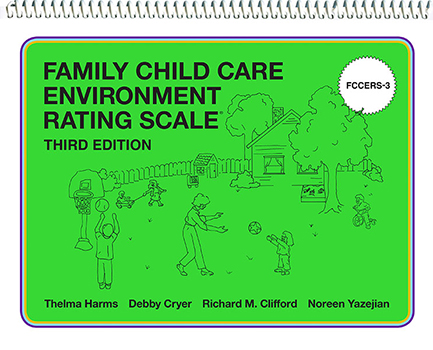
The original Family Day Care Rating Scale (FDCRS; Harms & Clifford, 1989) contained 34 Items organized into 7 subscales. Each Item was presented as a 7-point Likert-type scale with four quality levels, with each level defined by a descriptive paragraph that illustrated the expected aspects of quality at that level. The FCCERS-R™ Edition (Harms, Cryer, & Clifford, 2007) consisted of 38 Items organized into 7 subscales. In the revised edition, each level of each Item was defined by numbered indicators. This change enabled assessors to more accurately assign scores and to use the measure more precisely to guide program improvement. It also included an expanded Scoresheet and expanded notes for clarification. The updated FCCERS-R™ served as the basis for the completely revised FCCERS-3™. We have maintained the use of indicators evaluated on the basis of child care home observation, and have added and revised Items and indicators significantly to reflect current research, knowledge, and practice in the field.
It is often said that a family child care home (FCCH) is “good” because the children they care for are treated just as the providers’ own children would be. But this point does reflect the complexity of providing for care for a wider group of often unrelated children. The goal is to ensure the positive development we want for every child. In fact, it is challenging for any parent to meet the developmental needs of even one child to maximize positive development. In family child care, where a provider must meet the needs of a group of children who may differ substantially in ages, abilities, and cultural backgrounds, the challenges multiply exponentially. A comprehensive, reliable, and valid instrument that assesses process quality and quantifies what is observed to be happening in a FCCH can play an important role in improving the quality of care and educational experiences received by the children.
In order to define and measure quality, the FCCERS-3™ draws from three main sources: research evidence from a number of relevant fields (health, development, and education), professional views of best practice, and real experiences of FCCH providers, including the practical constraints of real life in a family child care setting. The requirements of the FCCERS-3™ are based on what these sources judge to be important conditions for positive outcomes in children both while they are in the program and long afterward. The guiding principle here, as in all of our environment rating scales, has been to focus on what we know to be good for children.
